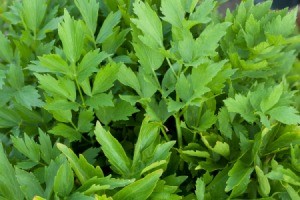

| Botanical Name: |
| Levisticum officinale |
| Common names: |
| Old English Lovage, Italian Lovage and Cornish Lovage |
| Description: |
| Every part of Lovage, with the exception of the small, umbel-shaped yellow flowers, can be harvested and utilized in medicinal, culinary or cosmetic ways. At 5 or 6 feet tall, these leafy plants have the look and scent of overgrown celery and are best planted in the back of the garden where their height and spread will not be an issue. |
| Life Cycle: |
| hardy perennial |
| Exposure: |
| full sun or partial shade |
| Cultivation: |
| Lovage prefers moist, fertile, well-drained soil, and is one the rare herbs that grow equally well in the sun and shade. Seeds should be sown in the late summer or early fall in a location where you want the plants to grow permanently and should be thinned so that only 2 or 3 hardy seedlings remain. Water Lovage regularly so that it doesn't dry out and give it a boost in the spring with some compost tea. Plants do not divide well, but can be propagated easily from cuttings. Plants die back naturally in the fall and go into a period of dormancy, but roots should be mulched in zones with harsh winters to protect them from cold damage. |
| Propagation: |
| root cuttings and seeds |
| Parts Used: |
| leaves, seeds, roots and young stems |
| Harvesting and Storage: |
| Cut stems and leaves for drying in the fall. Take cuttings around the outside perimeter of the plants to avoid creating bare areas in the center of the plant. Lay them out flat or hang them up to dry in a warm, dark room with plenty of air circulation. This may take several weeks. Seed heads can also be hung up to dry. |
| Medicinal Uses: |
| diuretic; digestive aid; antiseptic |
| Culinary Uses |
| Leaves-soups; salads; Indian dishes; casseroles; sauces and marinated; Stems-candied or cooked as a vegetable; Seeds-flavoring for baked goods; Roots-peeled and cooked as a vegetable |
| Other Uses: |
| skin care; deodorant; tall borders and displays |
I'm smiling as I write this because this is one of my kitchen must-haves and right now I've got bunches of dried lovage hanging in my utility room ready for winter soups and stews. The room smells wonderful.
In the early summer I often put it in a vase with flowering chives to make a simple and pretty arrangement on my kitchen table.
Thank you for introducing this widely unknown plant to our tf.com friends.